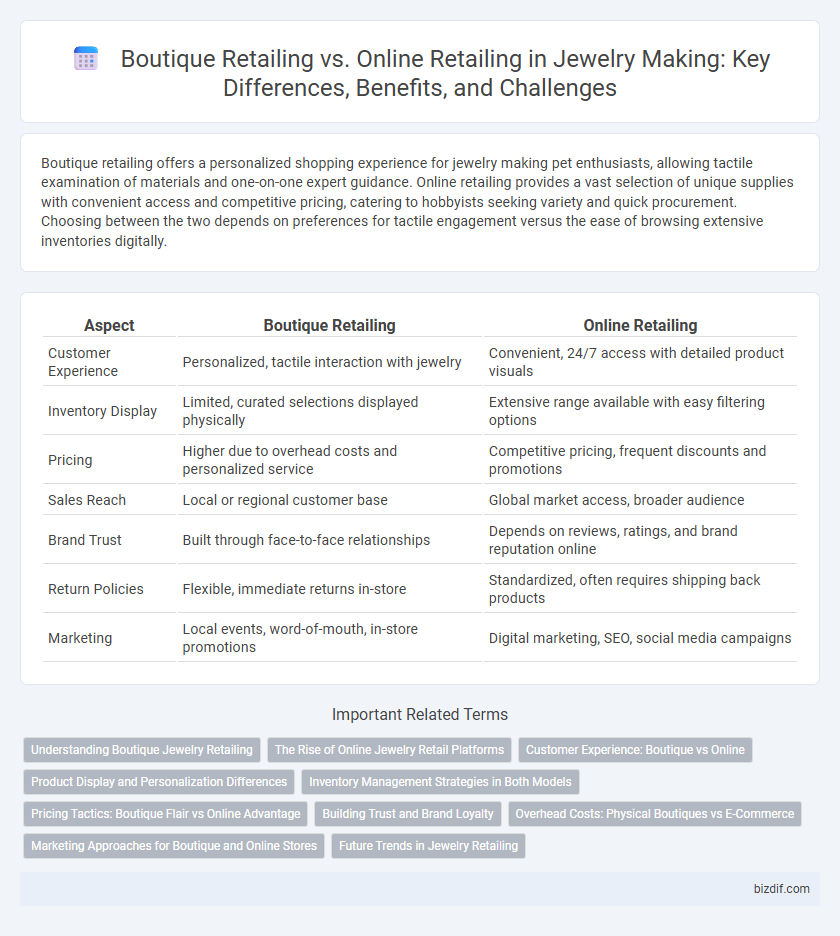Boutique retailing offers a personalized shopping experience for jewelry making pet enthusiasts, allowing tactile examination of materials and one-on-one expert guidance. Online retailing provides a vast selection of unique supplies with convenient access and competitive pricing, catering to hobbyists seeking variety and quick procurement. Choosing between the two depends on preferences for tactile engagement versus the ease of browsing extensive inventories digitally.
Table of Comparison
| Aspect | Boutique Retailing | Online Retailing |
|---|---|---|
| Customer Experience | Personalized, tactile interaction with jewelry | Convenient, 24/7 access with detailed product visuals |
| Inventory Display | Limited, curated selections displayed physically | Extensive range available with easy filtering options |
| Pricing | Higher due to overhead costs and personalized service | Competitive pricing, frequent discounts and promotions |
| Sales Reach | Local or regional customer base | Global market access, broader audience |
| Brand Trust | Built through face-to-face relationships | Depends on reviews, ratings, and brand reputation online |
| Return Policies | Flexible, immediate returns in-store | Standardized, often requires shipping back products |
| Marketing | Local events, word-of-mouth, in-store promotions | Digital marketing, SEO, social media campaigns |
Understanding Boutique Jewelry Retailing
Boutique jewelry retailing emphasizes personalized customer experiences, exclusive designs, and high-quality craftsmanship that appeal to discerning clients seeking unique pieces. This model often features limited inventory and detailed product knowledge provided by expert staff, enhancing customer trust and brand loyalty. Compared to online retailing, boutique stores leverage tactile engagement and intimate atmosphere to showcase intricate jewelry details and build lasting client relationships.
The Rise of Online Jewelry Retail Platforms
Online jewelry retail platforms have revolutionized the industry by offering extensive product variety, competitive pricing, and personalized virtual shopping experiences. Advanced technologies such as 3D visualization, augmented reality try-ons, and AI-driven recommendations enhance customer engagement beyond traditional boutique settings. The convenience of doorstep delivery combined with secure payment gateways drives increasing consumer preference for digital jewelry marketplaces over physical stores.
Customer Experience: Boutique vs Online
Boutique retailing in jewelry making offers a tactile and personalized customer experience, allowing clients to physically examine pieces and receive expert guidance tailored to their preferences. Online retailing provides convenience and broader selection, enhanced by virtual try-ons and detailed product descriptions to aid customer decision-making. Both channels use technology and personalized service to elevate customer satisfaction, but boutique stores excel in creating emotional connections through in-person interactions.
Product Display and Personalization Differences
Boutique retailing in jewelry making emphasizes tactile product displays, allowing customers to experience the weight, texture, and sparkle of pieces firsthand, fostering a personalized shopping environment with direct expert interaction. Online retailing offers dynamic digital displays featuring high-resolution images, 360-degree views, and virtual try-ons, providing convenience but limiting physical interaction. Personalization online often relies on AI-driven recommendations and customizable design options, whereas boutiques deliver tailored advice and customization through in-person consultations.
Inventory Management Strategies in Both Models
Boutique retailing in jewelry emphasizes personalized inventory management with limited, high-value pieces tailored to customer preferences, optimizing shelf space and reducing overstock risks. Online retailing leverages advanced data analytics and real-time demand forecasting to manage diverse, larger inventories efficiently across multiple warehouses, ensuring rapid order fulfillment. Both models integrate inventory management software but differ in scale and approach, where boutiques prioritize exclusivity and tactile experience, while online platforms prioritize scalability and variety.
Pricing Tactics: Boutique Flair vs Online Advantage
Boutique retailing in jewelry making leverages personalized pricing tactics and exclusive offers that foster a unique customer experience and justify premium prices. Online retailing capitalizes on competitive pricing strategies, frequent discounts, and dynamic pricing algorithms to attract price-sensitive shoppers and maximize sales volume. The contrast between boutique exclusivity and online affordability highlights distinct approaches to pricing optimization in the jewelry market.
Building Trust and Brand Loyalty
Boutique retailing in jewelry making fosters trust through personalized customer interactions and tactile experiences, allowing clients to closely examine craftsmanship and materials. Online retailing leverages detailed product descriptions, high-resolution imagery, and customer reviews to build credibility and maintain brand loyalty across digital platforms. Consistent quality, transparent policies, and responsive customer service are critical in both channels to secure long-term relationships with jewelry buyers.
Overhead Costs: Physical Boutiques vs E-Commerce
Physical boutiques incur higher overhead costs due to expenses like rent, utilities, and in-store staff salaries, significantly impacting profit margins in jewelry making. Online retailing drastically reduces these costs by eliminating the need for physical storefronts and enabling automation in customer service and inventory management. Lower overhead expenses in e-commerce allow jewelers to invest more in product quality, marketing, and competitive pricing strategies.
Marketing Approaches for Boutique and Online Stores
Boutique jewelry retailers leverage personalized customer experiences and localized marketing strategies, including in-store events and exclusive collections, to build strong client relationships and brand loyalty. Online jewelry stores emphasize digital marketing tactics such as search engine optimization (SEO), social media advertising, and influencer partnerships to reach wider, global audiences efficiently. Both channels utilize data analytics to tailor campaigns, but boutique retailing focuses more on tactile customer engagement while online platforms maximize digital reach and convenience.
Future Trends in Jewelry Retailing
Boutique retailing in jewelry emphasizes personalized customer experiences and exclusive collections, leveraging craftsmanship to attract discerning buyers seeking unique pieces. Online retailing continues to expand through AI-driven personalization, virtual try-ons, and augmented reality, enhancing convenience and customer engagement globally. Future trends indicate a hybrid model where brands integrate immersive digital tools with tactile in-store experiences, catering to diverse consumer preferences.
Boutique retailing vs online retailing Infographic

 bizdif.com
bizdif.com